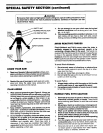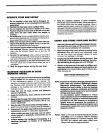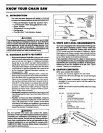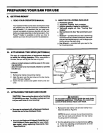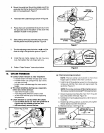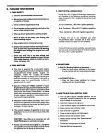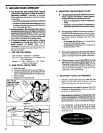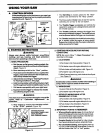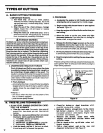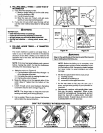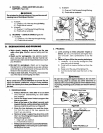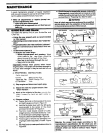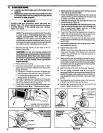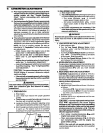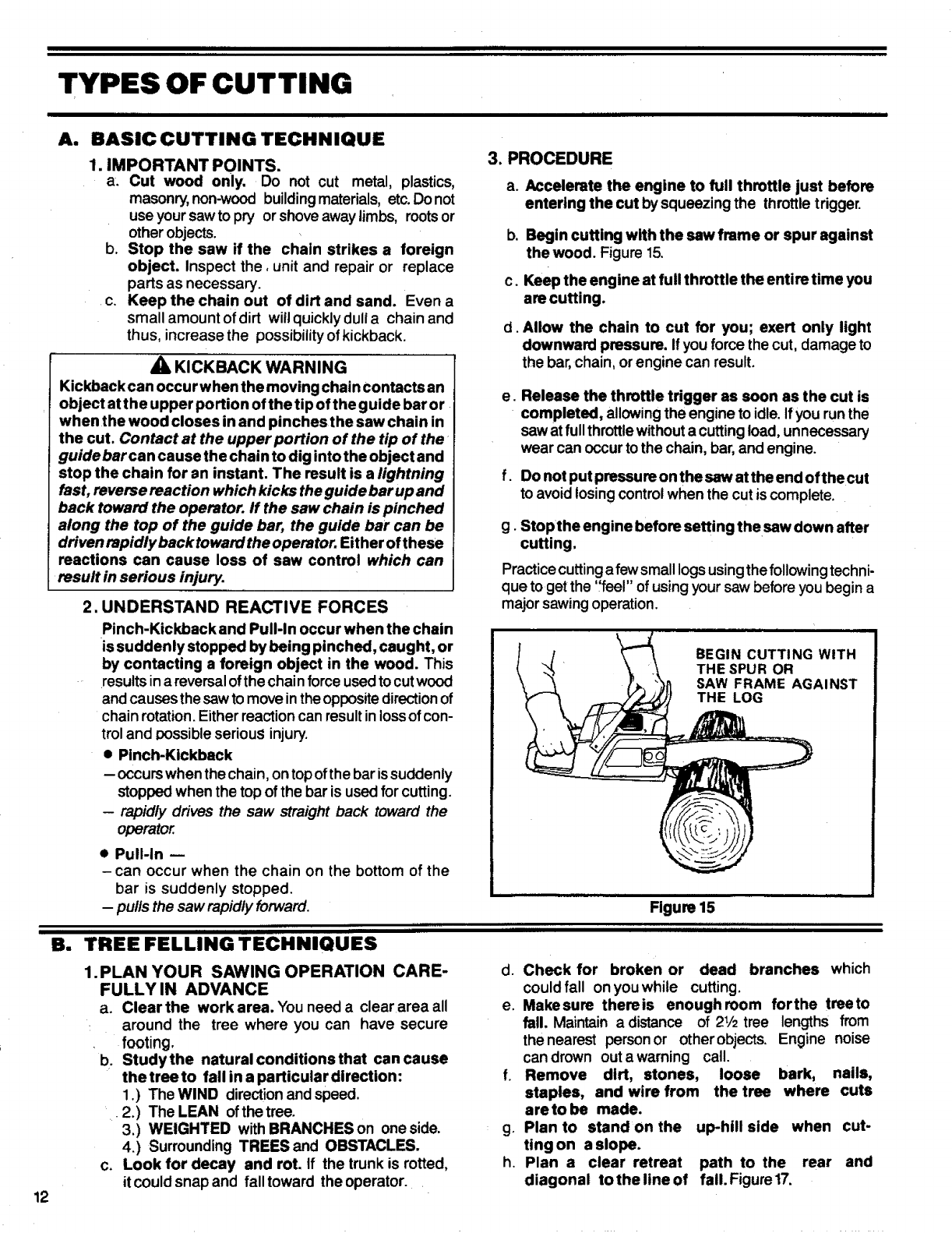
12
llllIIIII I III II I IIIIIIIIIIlllJl I
TYPES OF CUTTING
Illll II IIIII IIIII
A. BASIC CUTTING TECHNIQUE
1. IMPORTANT POINTS.
a. Cut wood only. Do not cut metal, plastics,
masonry,non-wood buildingmaterials, etc.Donot
useyoursawto pry or shoveaway limbs, rootsor
otherobjects.
Stop the saw if the chain strikes a foreign
object. Inspect the, unit and repair or replace
parts as necessary.
Keep the chain out of dirt and sand. Even a
small amount ofdirt willquicklydulla chain and
thus, increase the possibilityofkickback.
3. PROCEDURE
a. Accelerate the engine to full throttle just before
entering the cut by squeezing the throttle trigger.
b. Begin cutting with the saw frame or spur against
the wood. Figure 15,
c. Keep the engine at full throttle the entire time you
are cutting.
b,
C,
KICKBACK WARNING
Kickback can occur when the moving chain contacts an
object at the upper portion of the tip of the guide bar or
when the wood closes in and pinches the saw chain in
the cut. Contact at the upper portion of the tip of the
guidebarcan cause the chain to dig into the object and
stop the chain for an instant. The result is a lightning
fast, reverse reaction which kicks the guide bar up and
back toward the operator. If the saw chain is pinched
along the top of the guide bar, the guide bar can be
driven rapidly back toward the operator. Either of these
reactions can cause loss of saw control which can
result in serious injury.
2, UNDERSTAND REACTIVE FORCES
Pinch-Kickback and Pull-In occur when the chain
issuddenly stopped bybeing pinched, caught, or
by contacting a foreign object in the wood. This
results inareversalofthechain forceusedtocutwood
and causes the sawtomove inthe oppositedirection of
chainrotation.Either reactioncan resultinlossofcon-
troland possible serious injury.
• Pinch-Kickback
-- occurswhen thechain, ontopofthebar issuddenly
stopped when the topof the bar isused for cutting.
-- rapidly drives the saw straight back toward the
operator
• Pull-In --
- can occur when the chain on the bottom of the
bar is suddenly stopped.
d. Allow the chain to cut for you; exert only light
downward pressure. Ifyou force the cut, damage to
the bar,chain, or engine can result.
e.
f.
Release the throttle trigger as soon as the cut is
completed, allowingthe engine to idle.Ifyou runthe
saw atfull throttlewithouta cuttingload, unnecessary
wear can occurtothe chain, bar,and engine.
Do not put pressure on the saw at the end of the cut
toavoidlosing controlwhen the cut iscomplete.
g. Stop the engine before setting thesaw down after
cutting.
Practice cuttingafew small logs usingthe following techni-
que toget the ,feel" ofusingyoursaw beforeyoubegin a
major sawingoperation.
BEGIN CUTTING WITH
THE SPUR OR
SAW FRAME AGAINST
THE LOG
i : ii i ...........................
Figure 15- pulls the saw rapidly forward.
B. TREE FELM'NGTECHNIQUES
1.PLAN YOUR SAWING OPERATION CARE-
FULLY IN ADVANCE
a. Clearthe work area. You need a clear area all
around the tree where you can have secure
footing.
b. Study the natural conditions that can cause
thetreeto fall in a particular direction:
1.) The WIND directionand speed.
2.) The LEAN ofthetree.
3.) WEIGHTED with BRANCHES on one side.
4.) Surrounding TREES and OBSTACLES.
c. Look for decay and rot. If the trunk is rotted,
itcould snap and fall toward the operator.
iiii
d.
e,
Check for broken or dead branches which
could fall on you while cutting.
Makesure thereis enoughroom forthe treeto
fall. Maintain a distance of 21/2tree lengths from
the nearest personor other objects. Engine noise
can drown outa warning call.
Remove dirt, stones, loose bark, nails,
staples, and wire from the tree where cuts
areto be made.
Plan to standOn the uphill side when cut-
ting on a slope.
Plan a clear retreat path to the rear and
diagonal to the line of fall. Figure17.



